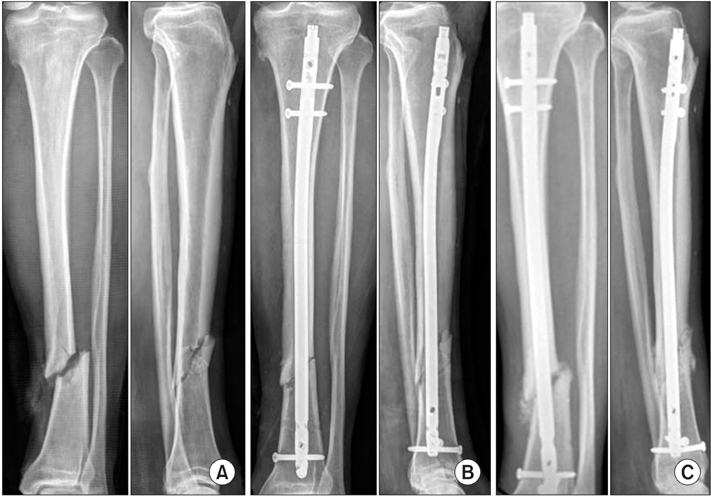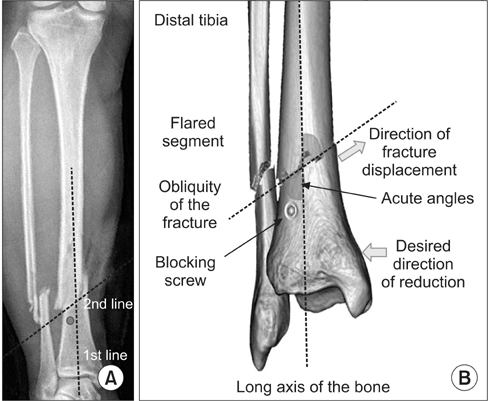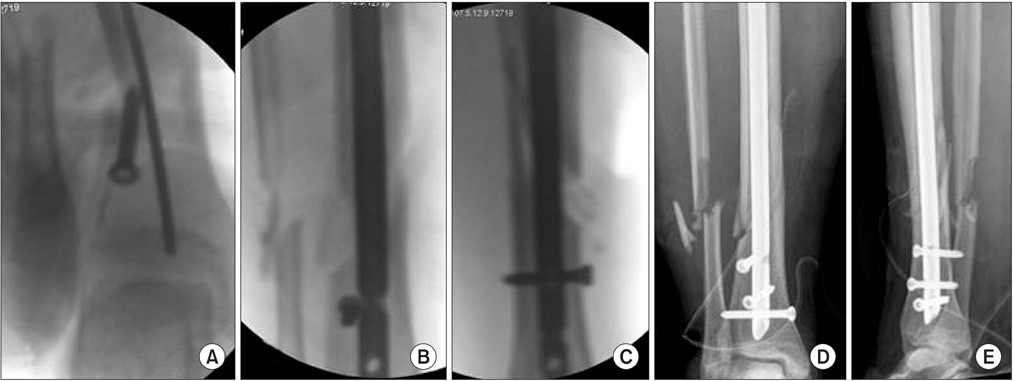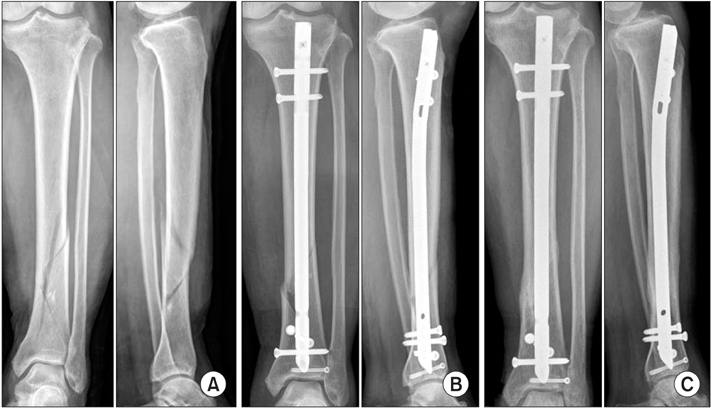J Korean Orthop Assoc.
2017 Jun;52(3):240-248. 10.4055/jkoa.2017.52.3.240.
The Usefulness of Blocking Screw in Intramedullary Nail of Distal Tibial Metaphyseal Fracture
- Affiliations
-
- 1Department of Orthopedic Surgery, School of Medicine, Chosun University, Gwangju, Korea. leejy88@chosun.ac.kr
- KMID: 2384554
- DOI: http://doi.org/10.4055/jkoa.2017.52.3.240
Abstract
- PURPOSE
To evaluate the usefulness of blocking screws in distal tibial metaphyseal fractures treated with intramedullary nailing.
MATERIALS AND METHODS
A total of 18 patients with distal tibial metaphyseal fractures, who underwent intramedullary nailing treatment with blocking screws between January 2012 and December 2014 and had a minimum follow-up of 1 year, were retrospectively reviewed for analysis. There were 7 patients with open fracture and 4 patients with intra-articular fracture. The location of the blocking screws was previously determined according to the fracture pattern. Moreover, the preoperative and postoperative angular alignment was measured. Patients received regular postoperative radiographic check-up, and the time-to-bone union and the incidence of nonunion were recorded. The clinical outcome was evaluated using the modified functional Kalstrom-Olerud score.
RESULTS
All fractures healed completely without nonunion at an average of 17.7 weeks. The mean coronal/sagittal alignment improved from 6.4/4.8 degrees preoperatively to 2.5/1.9 degrees postoperatively. The alignment was maintained until complete union. There were 3 cases of anterior knee pain but no complications related to the blocking screw and wound infection. Using a modified functional Karlstrom-Olerud score, the outcome was considered good to excellent in 83.4% of the patient cohort.
CONCLUSION
We conclude that the blocking screws may help the maintenance of reduction and alignment in distal tibial metaphyseal fractures treated with intramedullary nailing.
MeSH Terms
Figure
Reference
-
1. Ahlers J, von Issendorff WD. Incidence and causes of malalignment following tibial intramedullary nailing. Unfallchirurgie. 1992; 18:31–36.2. Coles CP, Gross M. Closed tibial shaft fractures: management and treatment complications. A review of the prospective literature. Can J Surg. 2000; 43:256–262.3. Nork SE, Schwartz AK, Agel J, Holt SK, Schrick JL, Winquist RA. Intramedullary nailing of distal metaphyseal tibial fractures. J Bone Joint Surg Am. 2005; 87:1213–1221.4. Rajasekaran S, Devendra A, Perumal R, Dheenadhayalan J, Sundararajan SR. Initial management of open fractures. In : Court-Brown CM, Heckman JD, McQueen MM, Ricci WM, Tornetta P, editors. Rockwood and green's fractures in adults. 8th ed. Philadelphia: Wolters Kluwer Health;2015. p. 353.5. Buehler KC, Green J, Woll TS, Duwelius PJ. A technique for intramedullary nailing of proximal third tibia fractures. J Orthop Trauma. 1997; 11:218–223.6. Freedman EL, Johnson EE. Radiographic analysis of tibial fracture malalignment following intramedullary nailing. Clin Orthop Relat Res. 1995; (315):25–33.7. Henley MB, Meier M, Tencer AF. Influences of some design parameters on the biomechanics of the unreamed tibial intramedullary nail. J Orthop Trauma. 1993; 7:311–319.8. Lang GJ, Cohen BE, Bosse MJ, Kellam JF. Proximal third tibial shaft fractures. Should they be nailed? Clin Orthop Relat Res. 1995; (315):64–74.9. Tornetta P 3rd, Collins E. Semiextended position of intramedullary nailing of the proximal tibia. Clin Orthop Relat Res. 1996; (328):185–189.10. Krettek C, Rudolf J, Schandelmaier P, Guy P, Könemann B, Tscherne H. Unreamed intramedullary nailing of femoral shaft fractures: operative technique and early clinical experience with the standard locking option. Injury. 1996; 27:233–254.11. Hannah A, Aboelmagd T, Yip G, Hull P. A novel technique for accurate Poller (blocking) screw placement. Injury. 2014; 45:1011–1014.12. Stedtfeld HW, Mittlmeier T, Landgraf P, Ewert A. The logic and clinical applications of blocking screws. J Bone Joint Surg Am. 2004; 86:Suppl 2. 17–25.13. Moghaddam A, Zimmermann G, Hammer K, Bruckner T, Grützner PA, von Recum J. Cigarette smoking influences the clinical and occupational outcome of patients with tibial shaft fractures. Injury. 2011; 42:1435–1442.14. Puno RM, Teynor JT, Nagano J, Gustilo RB. Critical analysis of results of treatment of 201 tibial shaft fractures. Clin Orthop Relat Res. 1986; (212):113–121.15. Nork SE, Barei DP, Schildhauer TA, et al. Intramedullary nailing of proximal quarter tibial fractures. J Orthop Trauma. 2006; 20:523–528.16. Vallier HA, Cureton BA, Patterson BM. Randomized, prospective comparison of plate versus intramedullary nail fixation for distal tibia shaft fractures. J Orthop Trauma. 2011; 25:736–741.17. Karlström G, Olerud S. Percutaneous pin fixation of open tibial fractures. Double-frame anchorage using the Vidal-Adrey method. J Bone Joint Surg Am. 1975; 57:915–924.18. Court-Brown CM, Rimmer S, Prakash U, McQueen MM. The epidemiology of open long bone fractures. Injury. 1998; 29:529–534.19. Iqbal HJ, Pidikiti P. Treatment of distal tibia metaphyseal fractures; plating versus intramedullary nailing: a systematic review of recent evidence. Foot Ankle Surg. 2013; 19:143–147.20. Im GI, Tae SK. Distal metaphyseal fractures of tibia: a prospective randomized trial of closed reduction and intramedullary nail versus open reduction and plate and screws fixation. J Trauma. 2005; 59:1219–1223. discussion 1223.21. Chan DS, Nayak AN, Blaisdell G, et al. Effect of distal interlocking screw number and position after intramedullary nailing of distal tibial fractures: a biomechanical study simulating immediate weight-bearing. J Orthop Trauma. 2015; 29:98–104.22. Agathangelidis F, Petsatodis G, Kirkos J, Papadopoulos P, Karataglis D, Christodoulou A. Distal locking screws for intramedullary nailing of tibial fractures. Orthopedics. 2016; 39:e253–e258.23. Helfet DL, Suk M. Minimally invasive percutaneous plate osteosynthesis of fractures of the distal tibia. Instr Course Lect. 2004; 53:471–475.24. Robinson CM, McLauchlan GJ, McLean IP, Court-Brown CM. Distal metaphyseal fractures of the tibia with minimal involvement of the ankle. Classification and treatment by locked intramedullary nailing. J Bone Joint Surg Br. 1995; 77:781–787.25. Williams TM, Marsh JL, Nepola JV, DeCoster TA, Hurwitz SR, Bonar SB. External fixation of tibial plafond fractures: is routine plating of the fibula necessary? J Orthop Trauma. 1998; 12:16–20.26. Attal R, Maestri V, Doshi HK, et al. The influence of distal locking on the need for fibular plating in intramedullary nailing of distal metaphyseal tibiofibular fractures. Bone Joint J. 2014; 96:385–389.27. Larsson S. Treatment of osteoporotic fractures. Scand J Surg. 2002; 91:140–146.
- Full Text Links
- Actions
-
Cited
- CITED
-
- Close
- Share
- Similar articles
-
- The Usefulness of Blocking Screw in Intramedullary Nail on Proximal Tibial Fracture
- Intramedullary Nailing in Distal Tibial Metaphyseal Fracture
- Subtrochanteric Fracture Reduction during Intramedullary Nailing: Technical Note
- A Bent Intramedullary Interlocking Tibial Nail: A Case Report
- Segmental Breakage of Distal Interlocking Screw Complicating removal of broken nail: A Case Report





